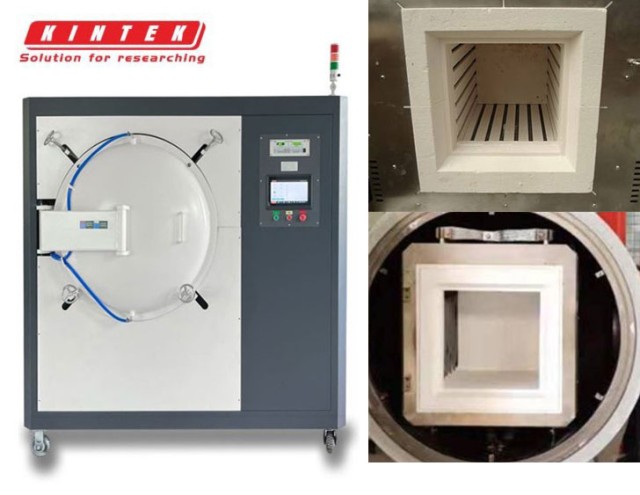Tipos de fornos de vácuo e aplicações gerais
Processos gerais em fornos de vácuo
Os fornos de vácuo são equipamentos versáteis capazes de efetuar uma vasta gama de processos complexos de tratamento térmico que, muitas vezes, ultrapassam as capacidades de outros equipamentos de tratamento térmico. Estes processos incluem têmpera e revenido em vácuo, recozimento em vácuo, tratamento de solução e envelhecimento em vácuo, sinterização em vácuo, tratamento térmico químico em vácuo e revestimento em vácuo. Cada um destes processos desempenha um papel crucial em várias aplicações industriais, garantindo que os materiais sofrem transformações precisas e controladas.
O fluxo de trabalho geral de um forno de vácuo pode ser dividido em várias etapas principais:
-
Carregamento do forno: O processo começa com a colocação das peças, ferramentas ou componentes na câmara. Dependendo do tamanho do forno, isto pode ser feito utilizando um suporte rolante ou um tabuleiro para fornos maiores, ou simplesmente abrindo a câmara e colocando as peças no interior para unidades mais pequenas.
-
Criação de um vácuo no interior da câmara: Depois de a câmara estar selada, o passo seguinte envolve a criação de vácuo no interior da câmara. Isto é conseguido através da inicialização da bomba para remover todo o oxigénio e manter uma vedação hermética. Os níveis de vácuo podem variar entre 1,3 x 10^-3 mbar (0,001 torr) e 6,7 x 10^-3 mbar (0,005 torr), normalmente atingidos em 10-30 minutos, dependendo do tamanho do sistema de bombagem e da natureza de quaisquer contaminantes presentes na carga de trabalho.
-
Aquecimento das peças: Uma vez estabelecido o vácuo, o forno é enchido com um gás inerte, como o azoto, o árgon ou uma mistura de azoto/hidrogénio (máximo de 3%), para uma gama de pressão de 66,7 x 10^1 mbar (500 torr) negativa a 0,10 bar (1,5 psig) positiva. O aquecimento começa então, envolvendo frequentemente ciclos duplos de bombagem para acelerar o tempo total do ciclo. As peças são aquecidas até à temperatura pretendida e embebidas para garantir uma distribuição uniforme da temperatura.
-
Arrefecimento e acabamento: Após atingir o ponto de referência e a temperatura de imersão, inicia-se o ciclo de arrefecimento. Esta fase é crucial, uma vez que determina as propriedades finais do material, quer se trate de um arrefecimento rápido, de um arrefecimento controlado ou de outros protocolos de arrefecimento específicos.
A capacidade de realizar estes processos complexos num ambiente de vácuo torna os fornos de vácuo indispensáveis em indústrias onde a precisão e a integridade do material são fundamentais.
Classificação dos fornos de vácuo
Os fornos de vácuo são classificados em vários tipos, cada um concebido para aplicações industriais específicas. Estes incluem fornos de brasagem a vácuo, fornos de têmpera a ar a vácuo, fornos de sinterização a vácuo, fornos de recozimento a vácuo, fornos de têmpera a vácuo, fornos de têmpera a óleo a vácuo e fornos de cementação a vácuo, entre outros.
Fornos de sinterização por vácuo
Os fornos de sinterização a vácuo são particularmente especializados, classificados com base nos seus métodos de aquecimento:
- Forno de aquecimento por resistência: Utiliza um fio ou elétrodo de resistência como fonte de aquecimento, oferecendo um aquecimento uniforme e um controlo simples, adequado para uma vasta gama de materiais.
- Forno de indução: Utiliza a indução electromagnética para um aquecimento rápido, permitindo um aquecimento localizado e é ideal para materiais específicos.
- Forno de feixe de electrões: Utiliza um feixe de electrões para um aquecimento extremamente rápido, capaz de atingir temperaturas elevadas, tornando-o adequado para materiais refractários de alta temperatura.
Além disso, os fornos de sinterização a vácuo podem ser classificados de acordo com as suas temperaturas de trabalho:
- Forno de sinterização a vácuo de baixa temperatura: Funciona abaixo de 1000°C, ideal para materiais sinterizados a baixa temperatura.
Fornos de recozimento a vácuo
Os fornos de recozimento a vácuo são classificados principalmente em:
- Forno de recozimento horizontal a vácuo: Utilizado para recozimento a vácuo de materiais especiais como aço inoxidável, núcleo de aço selénio, peças de metais preciosos e rebites e folhas compostas de prata-cobre.
- Forno de recozimento a vácuo do tipo poço: Especificamente concebido para peças de desenho profundo em equipamento de canalização, garantindo superfícies não oxidadas e elevada produtividade.
Estas classificações realçam as diversas aplicações e funcionalidades especializadas dos fornos de vácuo em vários processos industriais.
Aplicações específicas de diferentes fornos de vácuo
Forno de brasagem a vácuo
O forno de brasagem a vácuo é um equipamento especializado concebido para realizar processos de brasagem num ambiente de vácuo controlado. Este ambiente de vácuo é crucial, uma vez que elimina a necessidade de fluxo, que é normalmente utilizado em métodos de brasagem convencionais para evitar a oxidação. Ao remover a necessidade de fluxo, o processo de brasagem a vácuo garante que a junta esteja limpa e livre de contaminantes, levando a uma ligação durável e de alta qualidade.
Este tipo de forno é particularmente adequado para a brasagem de componentes complexos e materiais sensíveis que requerem um controlo preciso da temperatura. É amplamente utilizado em indústrias onde a integridade da junta é fundamental, como a aeroespacial, a automóvel e a eletrónica. O forno de brasagem a vácuo pode lidar com uma variedade de materiais, incluindo ligas de alumínio, aço inoxidável, ligas de titânio, carbonetos cimentados, ligas de alta temperatura e metais não ferrosos.
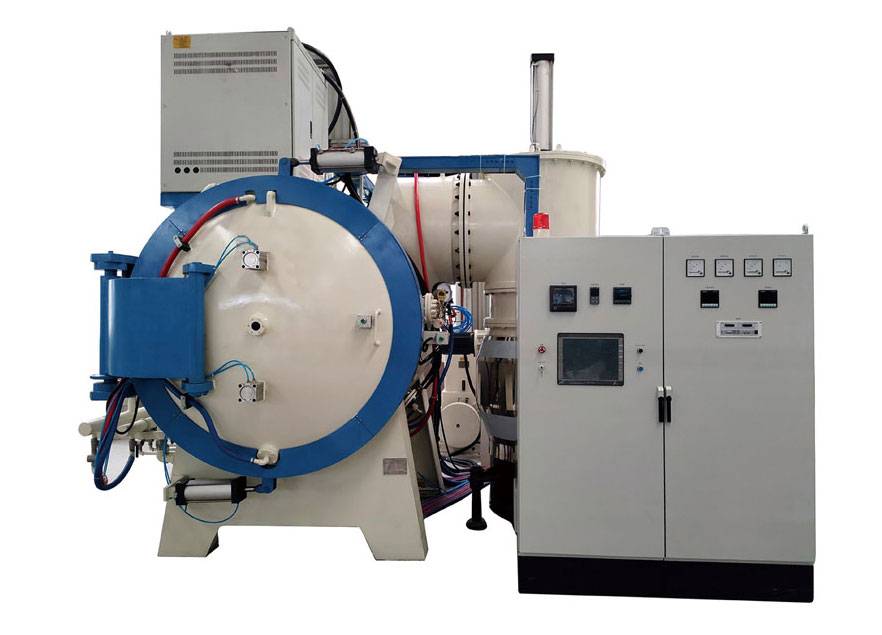
Principais aplicações
-
Trocadores de calor de liga de alumínio: O forno de brasagem a vácuo é utilizado principalmente para a brasagem de permutadores de calor em liga de alumínio e outros produtos de alumínio. Esta aplicação garante que os permutadores de calor são robustos e eficientes, adequados para ambientes de alto desempenho.
-
Aço inoxidável e ligas de titânio: Estes materiais são frequentemente utilizados em aplicações de alta tensão onde a força e a resistência à corrosão são críticas. O processo de brasagem a vácuo assegura que estes materiais são unidos sem comprometer as suas propriedades.
-
Aço rápido e aço para moldes: Para ferramentas e matrizes, o forno de brasagem a vácuo fornece a precisão e a limpeza necessárias para garantir que as ferramentas mantenham a sua nitidez e durabilidade.
-
Têmpera a vácuo: Para além da brasagem, o forno de brasagem por vácuo também pode ser utilizado para a têmpera por vácuo de vários materiais, incluindo aço rápido, aço para moldes e aço para rolamentos. Esta dupla funcionalidade torna-o uma ferramenta versátil no processamento de materiais.
O processo de brasagem a vácuo
O processo de brasagem a vácuo envolve vários passos críticos para garantir uma brasagem bem sucedida:
-
Limpeza e preparação: O primeiro passo envolve a limpeza completa das peças a serem unidas. Este passo é essencial para remover quaisquer contaminantes, tais como óleo, gordura ou óxidos, que possam interferir com o processo de brasagem. Os métodos de limpeza mais comuns incluem a limpeza por ultra-sons, o desengorduramento por vapor e o ataque químico.
-
Montagem e Fixação: Após a limpeza, as peças são montadas e fixadas para manter o alinhamento e o espaçamento corretos durante o processo de brasagem. As fixações são normalmente feitas de materiais com um baixo coeficiente de expansão térmica para evitar qualquer distorção ou desalinhamento durante o processo de aquecimento.
Ao seguir estes passos, o forno de brasagem por vácuo assegura que o produto final cumpre os requisitos rigorosos de várias aplicações industriais, fornecendo uma solução fiável e duradoura para unir componentes complexos.
Forno de têmpera a vácuo
Os fornos de têmpera a vácuo são peças especializadas de equipamento concebidas para processos de tratamento térmico de alta precisão. Estes fornos são particularmente adequados para o tratamento de aço de alta velocidade, aço para ferramentas, aço para moldes, ligas de aço estrutural e outros materiais semelhantes. A principal função de um forno de têmpera a vácuo é efetuar a têmpera a gás a alta pressão, o que garante que os materiais são submetidos a um arrefecimento preciso e controlado, melhorando assim as suas propriedades mecânicas.
Para além da têmpera por gás a alta pressão, os fornos de têmpera por vácuo também podem ser utilizados para a brasagem a alta temperatura de materiais de aço inoxidável, tratamentos de soluções sólidas e sinterização de materiais em pó. Estes fornos versáteis são capazes de recozimento e arrefecimento rápido de soluções, tornando-os indispensáveis em indústrias que requerem processos avançados de tratamento térmico.
O design único e o desempenho avançado dos fornos de têmpera a vácuo proporcionam uma vasta gama de capacidades de têmpera a gás brilhante a vácuo para peças de alta precisão, tais como aço de alta velocidade, aço para moldes, aço inoxidável, ligas de aço e ligas de titânio. Isto assegura que as peças tratadas mantêm a sua integridade e precisão com o mínimo de deformação.
Além disso, a integração de sistemas de controlo avançados, como o software KinTek, melhora a automatização e o controlo globais destes fornos. Estes sistemas oferecem efeitos de animação realistas e atributos funcionais personalizados, tornando o funcionamento do forno mais prático e fácil de gerir.
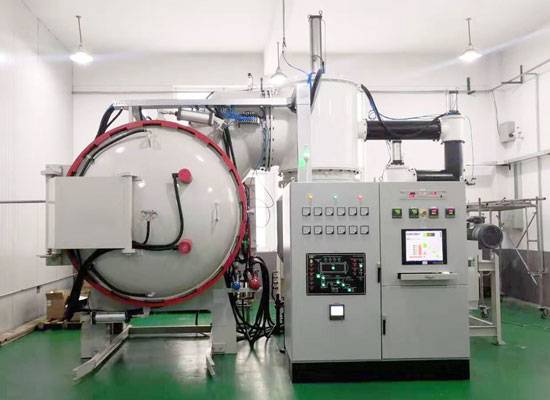
Os fornos de têmpera a vácuo não se limitam apenas à têmpera a gás; também podem efetuar a têmpera a óleo, o que é particularmente útil para materiais que requerem diferentes meios de arrefecimento. Esta dupla capacidade assegura que uma variedade de materiais pode ser tratada eficazmente, desde o aço de cementação e o aço de liga para ferramentas até ao aço de alta velocidade e ao aço inoxidável.
Em resumo, os fornos de têmpera a vácuo são ferramentas essenciais no domínio do tratamento térmico avançado, oferecendo um conjunto abrangente de processos que satisfazem uma vasta gama de necessidades industriais. A sua capacidade de realizar têmpera a gás a alta pressão, brasagem a alta temperatura, tratamentos de soluções sólidas e sinterização de materiais em pó, juntamente com a integração de sistemas de controlo avançados, torna-os uma pedra angular na produção moderna e na ciência dos materiais.
Forno de sinterização a vácuo
Os fornos de sinterização por vácuo funcionam sob vácuo, muitas vezes complementado com proteção de hidrogénio, para criar um ambiente ideal para a sinterização de peças delicadas e complexas. Estes fornos utilizam aquecimento por indução de média frequência, que gera temperaturas elevadas num cadinho de tungsténio localizado no interior da bobina. Este calor é então transferido através de radiação térmica para as peças de trabalho, normalmente ligas refractárias como o tungsténio, o molibdénio e as suas ligas, que são cruciais na investigação científica e em aplicações militares.
O processo de sinterização a vácuo é particularmente vantajoso para a produção de componentes que são difíceis de fabricar através da fundição ou maquinagem tradicionais. Permite a união eficiente de peças com o mínimo de desperdício, resultando em peças consistentes e brilhantes, sem costuras, juntas ou enchimentos. Este método é altamente benéfico para tecnologias como o metal em pó, a moldagem por injeção de metal e a impressão 3D, melhorando a qualidade e a flexibilidade.
Existem dois tipos principais de fornos de sinterização a vácuo: horizontal e vertical. A escolha entre estes tipos depende frequentemente dos requisitos específicos do processo de sinterização e da disposição do espaço de trabalho. Os locais de instalação destes fornos têm de cumprir normas rigorosas de saúde a vácuo, assegurando que o ar circundante é limpo, seco e bem ventilado para evitar a contaminação e a acumulação de poeiras.
As vantagens da utilização de um forno de sinterização por vácuo são múltiplas. Oferece uma flexibilidade de conceção incrível, tempos de execução rápidos, qualidade superior e menos defeitos. Para além disso, estes fornos são relativamente fáceis de manter, contribuindo para uma produtividade máxima. O processo de sinterização propriamente dito começa com a desbobinagem, um passo crítico que prepara o terreno para a transformação de materiais em pó em componentes densos e de elevado desempenho. Este processo influencia significativamente a microestrutura do material, afectando o tamanho do grão, o tamanho dos poros e a distribuição dos limites do grão, o que, por sua vez, tem impacto nas propriedades gerais do produto final.
Forno de recozimento a vácuo
O forno de recozimento a vácuo é um equipamento especializado, concebido para efetuar processos de recozimento não oxidativo numa variedade de materiais, particularmente aço inoxidável e outros componentes metálicos de alta precisão. Este forno é essencial para as indústrias que lidam com rolamentos de aço inoxidável, ferramentas de corte, parafusos auto-roscantes auto-perfurantes e cavilhas de aço inoxidável, entre outros. A principal função do forno de recozimento a vácuo é manter a integridade e a qualidade da superfície destes componentes, evitando a oxidação durante os tratamentos a alta temperatura.
Uma das caraterísticas de destaque do forno de recozimento a vácuo é a sua capacidade de funcionar sob uma atmosfera protetora, normalmente utilizando azoto de alta pureza ou gás de decomposição de amoníaco. Este ambiente protetor assegura que os materiais a tratar permanecem livres de contaminantes e oxidação, resultando num acabamento superficial brilhante e sem mácula. A utilização de ventiladores de agitação aumenta ainda mais a uniformidade da temperatura do forno, garantindo um tratamento consistente em todos os componentes.
Para além das suas aplicações em aço inoxidável, o forno de recozimento a vácuo também é utilizado para recozimento brilhante não oxidativo de peças mecânicas, chapas de aço silício e vários materiais de cobre e fios. Esta versatilidade torna-o uma ferramenta crucial em sectores que vão desde o automóvel e aeroespacial até à eletrónica e engenharia de precisão.
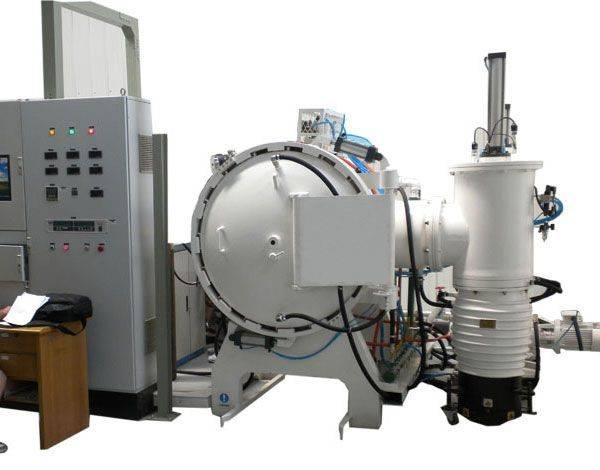
O forno de recozimento a vácuo não se limita apenas a aplicações em aço inoxidável, mas também estende as suas capacidades a outros materiais, como o titânio, o zircónio e as ligas refractárias. No campo da metalurgia do pó, desempenha um papel significativo na sinterização de metais activos e reactivos, assegurando que estes materiais mantêm a sua integridade estrutural e propriedades mecânicas.
Além disso, a capacidade do forno de recozimento a vácuo de funcionar sob vácuo ou atmosfera protetora torna-o ideal para aplicações de alta precisão em que é fundamental evitar reacções gasosas a temperaturas elevadas. Esta capacidade garante que os componentes tratados cumprem os rigorosos padrões de qualidade exigidos em indústrias como a aeroespacial, dispositivos médicos e eletrónica avançada.
Em resumo, o forno de recozimento a vácuo é uma ferramenta versátil e indispensável em vários processos industriais, oferecendo alta produtividade, qualidade de superfície superior e a capacidade de lidar com uma ampla gama de materiais. As suas caraterísticas de atmosfera protetora e uniformidade de temperatura fazem dele a escolha preferida para manter a precisão e a integridade de componentes de elevado valor.
Forno de têmpera a vácuo
Os fornos de têmpera a vácuo são equipamentos especializados concebidos para satisfazer os requisitos exactos de têmpera de componentes com uma superfície brilhante e sem oxidação. Estes fornos são particularmente adequados para o tratamento de têmpera a alta temperatura de aço para moldes, ligas de alta temperatura, ligas elásticas, ligas de cobre, ligas de titânio e várias ligas de cobre e cobre. O processo não só assegura que as peças tratadas mantêm a sua integridade estrutural e propriedades mecânicas, como também elimina o risco de oxidação da superfície, resultando num acabamento impecável.
Para além das aplicações de alta temperatura, os fornos de têmpera a vácuo também são utilizados para processos de recozimento de desestressamento e amolecimento. Esta dupla funcionalidade é crucial para materiais que requerem tanto resistência como flexibilidade, como no fabrico de ferramentas e componentes de precisão. A capacidade do forno para arrefecer rapidamente o material assegura que o produto final mantém as propriedades desejadas sem comprometer a durabilidade ou o desempenho.
O ambiente de vácuo dentro destes fornos desempenha um papel fundamental na obtenção destes resultados. Ao remover o oxigénio atmosférico, o risco de oxidação da superfície é praticamente eliminado, permitindo a criação de peças com um acabamento consistentemente brilhante e sem mácula. Isto é particularmente importante nas indústrias em que a integridade estética e estrutural dos componentes é fundamental, como nos sectores aeroespacial e de dispositivos médicos.
Além disso, o controlo preciso das taxas de aquecimento e arrefecimento garante que os materiais sofrem as transformações necessárias sem introduzir quaisquer tensões ou deformações indesejadas. Este nível de controlo é essencial para manter a precisão dimensional e as propriedades mecânicas do produto final, tornando os fornos de têmpera por vácuo uma ferramenta indispensável nos processos de fabrico de alta precisão.
Forno de têmpera de óleo sob vácuo
Os fornos de têmpera em óleo sob vácuo são equipamentos especializados concebidos para o tratamento térmico sob vácuo de vários aços de elevado desempenho, incluindo aço para moldes, aço para molas, aço inoxidável, aço para rolamentos e ligas de aço de alta temperatura. Este tipo de forno é particularmente apreciado pela sua capacidade de combinar o tratamento térmico sob vácuo com processos de recozimento, oferecendo uma solução versátil para o endurecimento e a têmpera de materiais.
Uma das principais vantagens do forno de têmpera em óleo sob vácuo é a sua ampla aplicabilidade em diferentes tipos de aço. O forno foi concebido para garantir uma excelente temperabilidade, o que o torna adequado para uma vasta gama de materiais que requerem um tratamento térmico preciso para obter propriedades mecânicas óptimas. Além disso, a relação custo-eficácia deste processo é digna de nota, uma vez que o óleo de têmpera utilizado pode ser reciclado e reutilizado, reduzindo as despesas operacionais e o impacto ambiental.
No entanto, os fornos de têmpera em óleo a vácuo têm as suas limitações. Um inconveniente significativo é o grau relativamente elevado de deformação que ocorre durante o processo de têmpera. Esta deformação requer uma limpeza subsequente e, possivelmente, etapas de acabamento adicionais para restaurar a peça de trabalho para as dimensões e qualidade de superfície desejadas.
Do ponto de vista estrutural, os fornos de têmpera em óleo sob vácuo podem ser classificados em modelos de duas e três câmaras. Estas configurações oferecem diferentes eficiências operacionais e utilização de espaço, satisfazendo várias necessidades de produção e tamanhos de peças.
Em termos de segurança e eficiência, o funcionamento de um forno de arrefecimento de óleo por vácuo envolve a utilização de azoto durante o processo de arrefecimento. Ao encher a câmara de arrefecimento de óleo com azoto a uma pressão de 0,4-0,67 x 10^5 Pa (300-500 Torr), o forno aumenta a capacidade de arrefecimento do óleo de têmpera. Isto não só ajuda a peça de trabalho a atingir a dureza de têmpera desejada sob pressão normal, como também reduz significativamente a volatilização do óleo de têmpera, minimizando assim a névoa de óleo e melhorando a segurança geral. Este método de arrefecimento assistido por azoto também contribui para uma menor perda de óleo e menos poluição dentro do forno, beneficiando assim a qualidade do produto e a segurança operacional.
Forno de cementação a vácuo
O forno de cementação a vácuo destaca-se como uma ferramenta versátil no domínio dos processos de tratamento térmico, capaz de executar uma miríade de operações, tais como cementação a vácuo, carbonitretação a vácuo e combinações de cementação com têmpera a óleo ou a gás. Esta flexibilidade estende-se às funções departamentais do forno de vácuo, tornando-o uma pedra angular em aplicações industriais em vários materiais e componentes que requerem tratamento térmico.
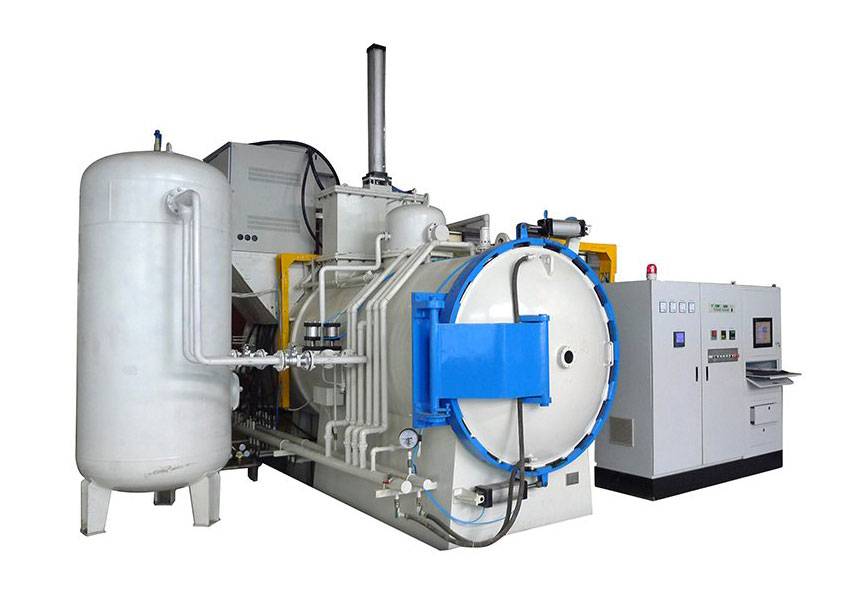
Uma das principais vantagens da cementação a vácuo é a sua compatibilidade ambiental, uma vez que funciona sem emissões de CO2, distinguindo-a dos métodos tradicionais de cementação atmosférica. Este processo envolve o aquecimento de peças de aço a temperaturas que variam tipicamente entre 900-1000°C num ambiente controlado e de baixa pressão. O objetivo é infundir carbono na camada superficial, aumentando assim a sua dureza e resistência ao desgaste, preservando ao mesmo tempo um núcleo maleável. A pós-carbonetação, o endurecimento e a têmpera são normalmente efectuados, aproveitando as vantagens do ambiente de vácuo e de gases de transporte como o acetileno (C2H2).
As aplicações da cementação sob vácuo são extensas, abrangendo desde aços de cementação de alta liga como o 12Cr2NI4A e o 12CrNi3A até aços estruturais como o 20CrMnTi, e mesmo aços inoxidáveis como o 1Cr13. É igualmente indispensável para o tratamento térmico de aços de molde como o H13 e o W6Mo5Cr4V2, bem como de componentes como engrenagens, casquilhos, rolamentos de precisão, bombas de óleo, bocais e outras peças mecânicas de precisão. Esta ampla aplicabilidade sublinha o papel fundamental do forno de cementação a vácuo para garantir a durabilidade e o desempenho de uma vasta gama de componentes industriais.
Produtos relacionados
- Forno de brasagem por vácuo
- Forno de vácuo para prensagem a quente
- Forno de arco de vácuo Forno de fusão por indução
- Forno de sinterização por pressão de vácuo
- Forno de prensagem a quente com tubo de vácuo
Artigos relacionados
- Fornos de laboratório a vácuo na investigação de materiais avançados
- Forno de fusão por vácuo: um guia completo para a fusão por indução por vácuo
- Explorando fornos de tungstênio a vácuo: Funcionamento, aplicações e vantagens
- Inspeção de falhas do forno de indução a vácuo: Procedimentos e soluções essenciais
- Dominando a brasagem em forno a vácuo: Técnicas, Aplicações e Vantagens
